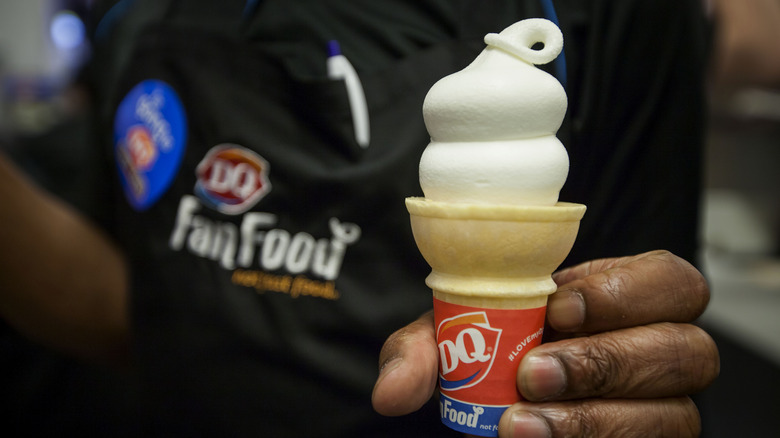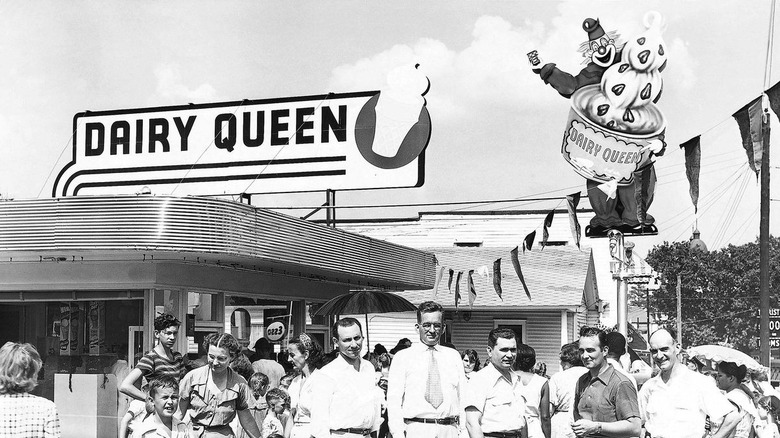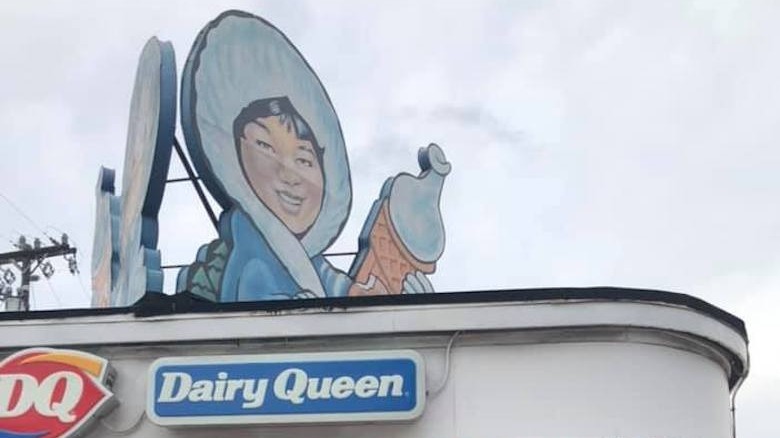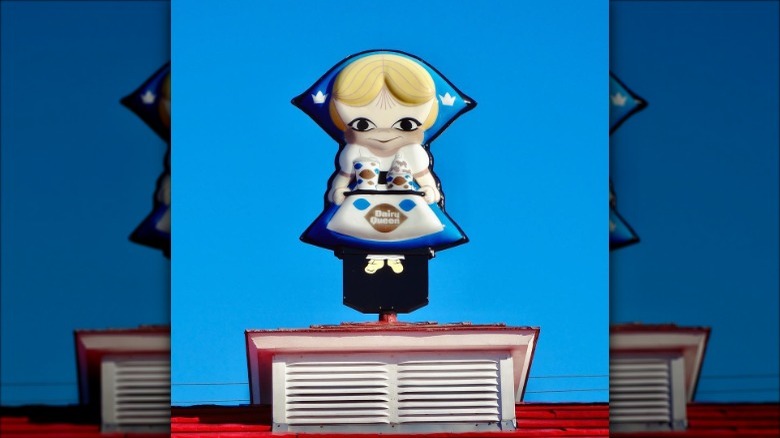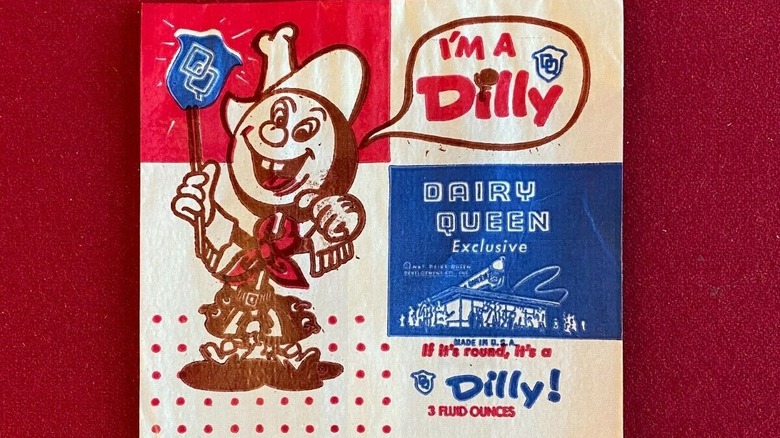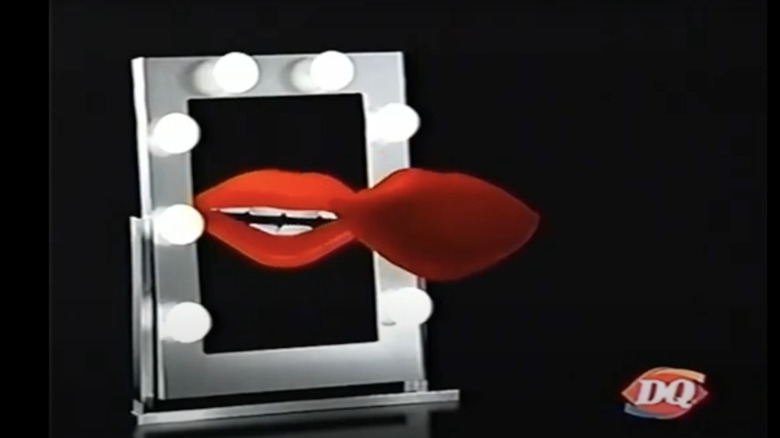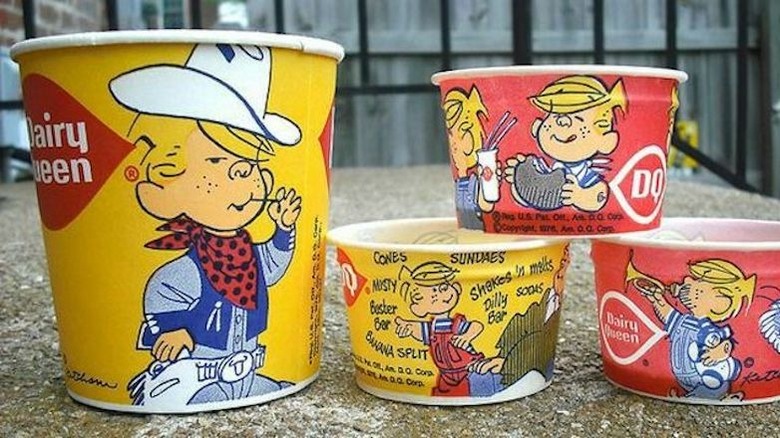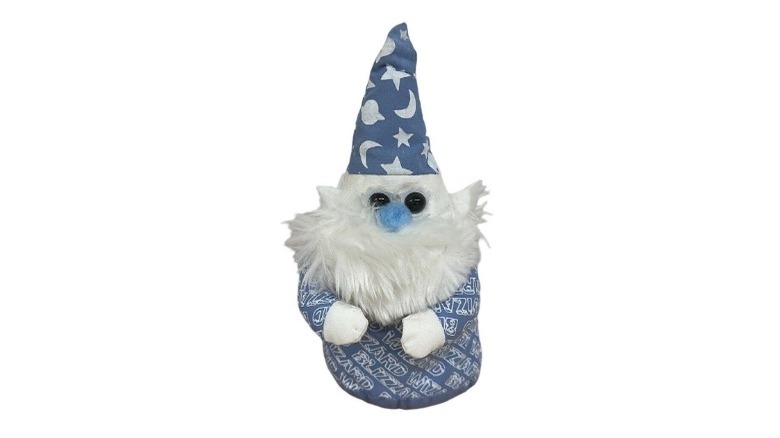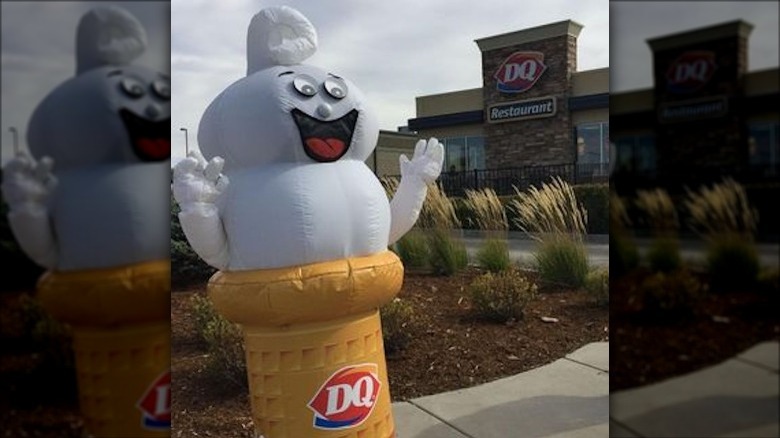Dairy Queen Has Had Some Strange Mascots Over The Years
Dairy Queen has been serving up cold treats since it opened in 1940 and has seen a lot of innovation in that time. From being an early franchise restaurant to its unique soft-serve product, the company is constantly changing and evolving. Some of those changes have been for the better. For example, famous Dairy Queen treats such as the Blizzard did not appear on the menu until the company had been in business for 45 years. Yet now it's hard to think of a Dairy Queen without these thick frozen treats.
In all the time Dairy Queen has existed, though, there have been some changes that have not always stuck around, specifically when it comes to mascots. Over the years, Dairy Queen has played host to various mascots that range from questionable to downright disconcerting, with some making multiple runs. We have compiled all of the Dairy Queen mascots over the years to have a complete look at all ways Dairy Queen has tried to get our attention.
Curly the clown
One of the earliest, if not the earliest, Dairy Queen mascots is Curly the Clown. Now, we can all agree that clowns, in general, can be kind of creepy, and the Dairy Queen Curly the Clown is no exception.
Curly the Clown appeared on neon signs in the 1940s and 1950s, at least a decade before the more famous fast food clown Ronald McDonald appeared. Curly the Clown is depicted as an animated clown in a red suit, a cap that is sometimes blue and sometimes red, hair that is sometimes yellow and sometimes blue, a bright red nose, big eyes, and a big smiling mouth. He appeared as part of Dairy Queen signs, holding a curly Dairy Queen cone in one hand and a giant cup of soft serve with the words Dairy Queen on it in front of his body.
While some of the Curly the Clown signs were stationary, some were made with motorized hands that could wave daringly at passers-by. Now there are thought to be just three original Curly the Clown signs left in existence.
The Inuit
After Curly the Clown, Dairy Queen rebranded with a new mascot, this one a person, often depicted as a baby, with dark hair, a thick coat with a fur collar, gloves, and holding a Dairy Queen soft serve cone. The depiction was a stereotype of a person from the Inuit community, a character is often referred to as "the Eskimo Baby"; however, the use of the term is not accepted by most in the community (who generally prefer "Inuit"). The signs began to show up during the 1950s, but the caricature may have been seen even earlier than that.
The cups and other materials have been out of use for a long time. However, there are still a few signs left that feature the character. One, located in Grafton, Virginia, was repainted and restored in 2016. The owner went so far as to demolish the original building and move the sign to the rebuilt location in 2019.
Dairy Queen corporate does not support the continued use of these signs but does not have the authority to have the signs removed. However, we understand why the company would prefer the signs be removed, as this mascot is both strange and offensive.
Little Miss Dairy Queen
Little Miss Dairy Queen first appeared in the 1960s as part of a marketing campaign to elicit a "country fresh" vibe. Little Miss Dairy Queen appears as a country milkmaid, complete with a blue dress and hat, blonde hair, and a white apron with the Dairy Queen logo on it. The whole idea was to give people the impression that Dairy Queen represented traditional ice cream making — ironically, Dairy Queen's frozen desserts are actually not legally considered to be ice cream because the product does not contain enough milk fat.
By 1962, Little Miss Dairy Queen was being installed as a weathervane on top of new stores, which were designed to look like barns. She also appeared in newspaper ads. Dairy Queen leaned so far into the "Little Miss" aesthetic that Little Miss Dairy Queen pageants were held at franchises across the country. All things come to an end though, and Little Miss Dairy Queen stopped appearing on new buildings and in ads for the company by the 1980s. Still, as of 2019, some eagle-eyed fans could still spot Little Miss Dairy Queen weather vanes on the top of some older Dairy Queen buildings.
Dilly Bar
Many of the Dairy Queen favorites were not part of the original lineup when the company first came on the scene in the 1940s. The Dilly Bar, for example, did not appear until 1955. It was created in Moorhead, Minnesota by the local Dairy Queen. The Dilly Bar consists of that signature Dairy Queen soft serve, formed into a round disc and coated with chocolate, almost like a Klondike bar served on a stick.
Like the Blizzard, though, it is hard to think of Dairy Queen without a Dilly Bar. This is probably why Dairy Queen worked hard to make Dilly, the Dilly Bar mascot, happen. While exact dates for Dilly are unavailable, a wrapper from the 1960s confirms it was available during that time period. Dilly appears as a cowboy ice cream bar, with the round bar acting as the cowboy's head, sporting a large grin, two arms with tasseled gloves, a bandana around his neck, and inexplicably two legs coming out of the stick, which have boots and what appear to be chaps and a belt. All of this is topped off with a large hat. There is a lot going on with this mascot, and we can see why this strange cowboy did not take off in the long term.
Floating Lips
Among the stranger mascots are a disembodied pair of bright red floating lips with startling white teeth. The lips were appearing in commercials as early as the 1970s. During this period of time, the lips often appeared as animated lips that then transformed into the red and white logo of Dairy Queen. We can see where the company was going with it, but the lips are still somewhat disconcerting.
However, Dairy Queen sure seemed to like the lips, as they made a return in the 2000s, where they took on more autonomy. In commercials, the lips appeared, courtesy of computer animation, alongside Dairy Queen treats, talking about them and acting as an official spokesperson and mascot for the company through 2006. This, we would argue, was even creepier than the original, and we are not the only people who think so. In 2011 Time listed the lips as one of the Top 10 Creepiest Product Mascots. Time rightly points out that the resemblance between the Dairy Queen's lips, which often appeared on a black background, and the beginning of "The Rocky Horror Picture Show" does not make us think of family fun.
Dennis the Menace
After not quite hitting the mark with its mascots, Dairy Queen decided to try a mascot that already had a well-known following. Starting in 1972, Dairy Queen began to license cartoon character Dennis the Menace to be a mascot for the company. Dennis Mitchell is a five-and-a-half-year-old kid who constantly finds himself in trouble, earning him the moniker Dennis the Menace. The comic first appeared in 1951, which meant it had a great following by the time Dairy Queen adopted this rascal as a mascot.
Over the years blond-haired cartoon Dennis, as well as the character Joey McDonald, appeared on cups, packaging, and in commercials. The campaign must have been successful because the company kept the never-aging Dennis the Menace as a mascot for 30 years, including through the much-panned Dennis the Menace movie, which came out in 1993. Dairy Queen cut ties with Dennis in 2002, as the company felt he was no longer relevant.
Blizzard Wizard
Dairy Queen premiered the Blizzard in 1985. Now of course it is hard to imagine a Dairy Queen without the thick soft serve mixed with all kinds of delicious treats, served upside down, as if by magic. The same year Dairy Queen produced a new mascot, complete with toys to go with it, called the Blizzard Wizard. The Blizzard Wizard was stout, wore a blue outfit that said "Blizzard Wizard" on it, had a long white beard, and topped his outfit with a pointed hat decorated with stars and planets.
Obviously, the Blizzard was enchanting enough on its own, and the Blizzard Wizard was eventually discontinued as a mascot. However, not to let such a good name go, Dairy Queen transformed the Blizzard Wizard into a job title. The Blizzard Wizard at Dairy Queen is really just an ice cream scooper customer service job with a fancy title. Still, we imagine making Blizzards is a big part of being a Blizzard Wizard and that is not a duty to take lightly.
Curly Top Cone
It makes sense that with so many other Dairy Queen original treat mascots, the company would bring the product that made it all happen to the forefront. Dairy Queen soft serve was developed in 1938 before the first Dairy Queen was even opened. The Dairy Queen vanilla soft serve is most recognizable as a cake cone filled with piped soft serve and that signature curl on top.
It is unclear as to when Dairy Queen officially adopted Curly Top Cone as the official Dairy Queen mascot, but it appears to have been as early as 1997, Dairy Queen was releasing plush toys of the vanilla cone with legs. Now, however, Curly, as it is known by the company, is the official mascot of the company and even gets its own job postings. Today Curly is predominantly a person walking around in a soft-serve cone suit, obviously with the curl on top. Is it a little strange to have an anthropomorphized soft-serve cone walking around? Yes. But no stranger than any of the other Dairy Queen mascots.
